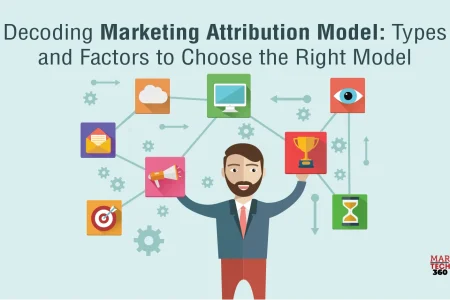Allocating or attributing credit for a sale is a key marketing function. However, it becomes more complex because of longer customer journeys and accessibility to multiple channels. It is less likely that a new prospect will directly visit your website and make a purchase after seeing an ad. Client journeys have become more intricate for both B2B and B2C companies.
According to a report, nearly 64% of marketers do not have the necessary tools to demonstrate the influence of marketing spend on company performance.
The target audience is more likely to see various ads for the same product or company across different social media platforms, podcasts, or print media. Any prospect might do a walk-in visit to the physical store or execute a search on their devices, and they sign up for newsletters using their work system. In this entire process, the prospect might have had at least five or more touch bases across multiple touchpoints over a couple of months. These touch points were essential in order to convert a prospect into a customer. However, tracking and determining these touchpoints can be a challenging task for marketing teams. This is where marketing attribution models come into the picture. If you are confused about the marketing attribution models, their types, and what factors to consider while selecting the right one for your organization, read along, this blog has some insights for you.
What are Marketing Attribution Models?
Marketing attribution is an approach to monitoring and evaluating the effectiveness of various touch points or integrated marketing channels. It is one of the most efficient ways to identify if and how every touch point influences prospective clients to convert into a customer. The best marketing attribution model enables marketers to work smarter rather than working hard. This approach allows marketing teams to determine where their efforts are effectively spent.
Different teams will have their unique approaches to attribute the value to their efforts. A marketing attribution model is an evaluation or forecast framework that can be applied to any marketing situation. It is the best way to monitor the multiple touch points the client interacts with during their purchase journey.
Also Read: Future-Proofing MarTech: Aligning People, Processes and Technology
What are the Types of Marketing Attribution Models?

Multi-source and single-source are the two key types of marketing attribution models.
A single-source marketing attribution model considers that the credit can be given to just a single channel or touchpoint. A multi-source marketing attribution model attempts to determine the impact of all the potential touchpoints that prospects interacted with that provoked them to make a purchase decision.
One key factor that defines the success of the attribution models is when they are in alignment with the business demands. For instance, if the organization is seeking to monitor top-of-the-funnel marketing conversions, it is suggested to depend on a single-source attribution modeling. Every attribution framework will have unique variations, and each of them will have its own advantages and challenges. Let us have a quick look at both of these models:
● Multi-Source Marketing Attribution Models
According to a report from MMA Global, approximately 53% of marketers leverage multi-touch attribution to monitor their marketing efforts.
The goal of this attribution model is to give the right amount of credit to every touchpoint or channel that the buyer interacts with. This marketing attribution approach is one of the most accurate ways as they allocate credits to all touch points throughout the customer journey.
One of the key bottlenecks in this approach is that it is not always possible to truly understand each channel’s contribution. Offline sources such as word of mouth and brand identity can also have an influence on the purchase decision, which is difficult to gauge. Additionally, the purchase decision-making process is a psychologically intricate process.
Even when organizations ask their clients to complete a survey, it can be difficult for them as well to understand what factors influenced their decision. Clients usually are unaware of the touch points they have interacted with and what impact each touchpoint had on them. Irrespective of these hurdles, the multi-source marketing attribution model aims to solve the puzzle in various ways. Following are a few types of attribution models that marketers can use:
1. W-shaped models
This attribution model spikes at three points similar to the letter W. These three peaks highlight the three touch points or events during the customer journey. It will spike at the starting visit of the prospect, the lead conversion, and the opportunities generated. Every touch point gets 30% credit, and the 10% is divided evenly between touch points that happen in the two bottom line intervals.
2. Time decay models
Such an attribution framework offers weightage to conversations that occur in the later stage of the purchase journey. The highest credits are given to the last conversation that closed the deal.
Marketers can utilize this model when they are more keen on exploring the channel that drives the highest conversion rates or work effectively at the bottom of the sales funnel. This approach is even effective when marketing teams want to put less focus on the top of the funnel but still want accountability for each channel.
3. Linear models
Linear marketing attribution models consider each conversation, but they allocate the credits evenly. Irrespective of how the chronology occurred in the customer journey, each touchpoint gets equal credit. Decision makers can leverage this model when they want to get a holistic view of their marketing techniques and general accounting of every channel integrated.
4. U-shaped models
This attribution framework offers 40% of the credit to the initial conversation and 40% to the last interaction. The rest 20% of the credits are divided between the second and the second-last touch points. Additionally, it can also divide the credits evenly throughout all the intermediate touchpoints. Marketing teams can leverage this approach when they want a balanced strategy. This approach is also effective when the in-between phases of decision-making are more ascertain; however, you still want to consider their impact on the purchase decision.
● Single-source Attribution Models
Single-source attribution models, while straightforward, come with both advantages and limitations.
1. First-Touch Models
The first-touch attribution model assumes that a customer’s decision to convert can be attributed to the very first marketing interaction they experienced. This model assigns full credit to that initial touchpoint, regardless of any other interactions that may have occurred along the way.
First-touch attribution offers a clear look at what grabs a potential customer’s attention first. It is particularly useful for understanding which marketing efforts are drawing in new leads and piquing interest. However, by focusing solely on that initial interaction, this model overlooks the entire customer journey. It can make other channels seem less valuable, even though they might play a crucial role later in the decision-making process.
2. Last-Touch Models
last-touch attribution gives all the credit to the customer’s final interaction before making a purchase. This model assumes the last marketing effort a customer encounters is solely responsible for their conversion, dismissing earlier engagements.
This marketing attribution model highlights what finally pushes a customer to make a purchase. It is helpful for identifying the actions or messaging that seal the deal. But, much like first-touch attribution, it leaves out the earlier influences. Without recognizing the full journey, important touchpoints that helped build momentum toward conversion can go unnoticed.
The accessibility to the vast range of attribution models offers marketers opportunities to customize their strategy according to the brand’s goals and needs. However, with so many various options, it can be difficult for marketers to decide on which approach suits their needs effectively. In the next section, let us have a look at the factors to consider when selecting the best marketing attribution model for their campaigns.
How to Choose the Right Marketing Attribution Model for Your Campaigns?
Below are a few factors that business decision-makers can consider while choosing the right marketing attribution model.
● Goals of the Campaign
Marketing leaders need to understand the goal of their existing marketing campaigns and the types of campaigns they have been running in their organization.
● Lifecycle of the Sales Cycle
It is crucial to determine the types of sales cycles embraced to ensure business continuity and the length of the sales cycle.
● Client Journey Road Map
Marketing teams need to have a clear picture of what client touchpoints are distributed throughout the marketing funnel. It is important to identify how fragmented or condensed they are. Additionally, there needs to be transparency about what channels are used for their campaigns.
Based on the organization’s needs and demands, marketing decision-makers can customize the marketing attribution model that suits their needs.
Marketing Attribution Models in a Nutshell
With a thorough understanding of how marketing attribution models work, decision-makers are well prepared to choose a model that assists them in determining how to allocate marketing budgets, enhance the campaigns, and bring in more prospective clients.
Choosing the best attribution model helps marketers to have an effective grasp of various touchpoints that impact the client’s decisions and where to allocate credit for the leads and sales.


